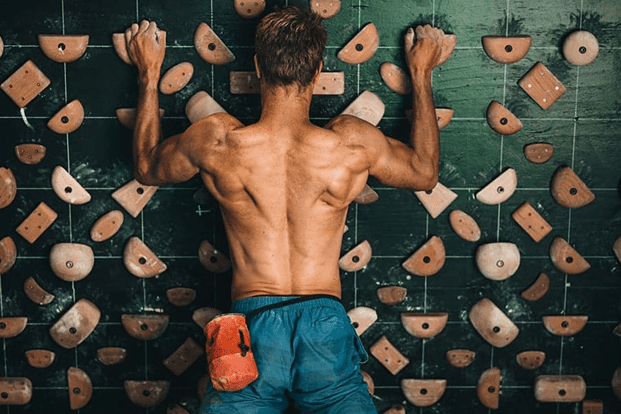Does Rock Climbing Build Muscle: What is the Rock-Climbing Full Body Workout?
Climbing is a full-body workout. You will not only be able to move up in climbing grades and send more difficult routes if you train for rock climbing, but you will also be able to achieve the perfect rock climber body with a little planning and guidance. Many of the activities involved with rock climbing training may tone your full-body game. When paired with a healthy diet, rock climbing will give you your best body and climber’s physique.

Spending time in the climbing gym or at the crag can help you keep a toned body composition and low body fat levels. Laps on the lattice board or splatter board are a great way to lose weight, build endurance, and improve technique and strength.
Can you climb up with fake nails? Check it out!!!
Another thing to keep in mind, especially for outdoor climbing, is that the approach may be physically demanding, and you’ll burn a lot of calories just getting to the start of your route. Time spent in nature is also beneficial to the psyche and makes many climbers feel more optimistic. These minor climbing habits have a great overall influence on your mind and body.
Is Rock Climbing a Good Workout?
In one session, you may grow muscle, improve coordination, improve flexibility, and get a decent aerobic exercise. Climbing rocks as a type of exercise allows you to cover a lot of territory. Climbing is a fantastic full-body activity that does amazing things for your body. The upper back and core are the primary climbing muscles, but your legs and a variety of other smaller muscle groups are also involved. For many people, climbing or bouldering has replaced going to the gym as a more pleasurable, social, and intellectually engaged form of exercise. You may choose between a vigorous training session and a leisurely stroll of the lovely routes.
Rock Climbing Techniques for Muscle Growth?
The major ones to concentrate on are finger grasping skills, foot positioning, and transition. You can experiment with different grasping techniques to grow and strengthen the muscles in your hands. Because it dictates the shape you adopt when climbing, foot placement aids in strengthening. This is another element that will assist you to enhance your transitional form. Because you may move your body in particular ways when climbing to tighten or train crucial regions, your technique aids with muscle gain.
Can Climbing Take the Place of Gym Workouts?
One of the primary reasons individuals become interested in climbing is that they do not want to go to the gym or perform a typical exercise but instead prefer to be more active. Climbing might substitute gym workouts depending on your goals. Climbing is an excellent cardio workout that can be substituted for many other gym routines. However, if you want to bulk up and be able to bench and squat double your body weight, weight lifting is still required.
What Muscles Are Used in Climbing?
Here, we’ll go over the major climbing muscles to give you an idea of which parts of your body are getting the most work on the wall.
1. Upper Body
Climbing, it goes without saying, strengthens your arms. The principal arm muscles involved in climbing are the forearm flexors, which are used to expand and shut your hands around things (such as a rock-climbing hold). When you start climbing, your upper body muscles will break and repair like crazy. And, of course, the frequency will grow as you get better at it, up to a point. Because you are constantly pulling and hanging in mid-air with your upper body, you will strengthen your forearm flexors, rhomboids, and anterior deltoid.
2. Core
Your core is a massive climbing powerhouse. Without your core muscles, you would be unable to accomplish the essential climbing motions. This is especially obvious while climbing an inclined wall or beginning to progress to more challenging climbs.
The abdominal muscles serve as stabilizers when climbing, making it impossible to keep your body safe on the rock without them. Engaging your core on overhanging routes helps to relieve the strain on your forearms, biceps, and back, allowing you to climb for longer periods of time with less upper-body weariness.
3. Lower Body
Finally, you’ll work on your lower body muscles such as your thighs, calf muscles, and toe tendons. In fact, novices will be encouraged to rely on their legs more than their upper bodies, causing leg muscles to swiftly develop. As rookie climbers improve their technique, they will start to rely less on their upper body to lift them up the wall and more on how their lower body can aid push them upwards.
Will Rock Climbing Assist Me in Losing Weight?
Probably. As a general approximation, rock climbing consumes approximately 9 times the energy of resting your body. It completely revs up your metabolism and burns so many calories that you’ll probably lose weight unless you change your diet.
That’s a whole other discussion, but if you go rock climbing to grow muscle, you might want to eat more carbs before you climb. As a rock climber, you will burn calories, and if you do not change your diet properly, you may find yourself a bit lighter as a result.
Final Thoughts
There’s no denying that many individuals are unsure whether or not they can rely only on rock climbing for muscular gain. However, most novices may improve and grow muscle in their first 90 days of rock climbing. This is determined by how high or quickly they climb, as well as the length of each session. They are far more likely to grow muscle if they climb at a high volume.
Climbing is a full-body workout that engages your upper, core, and lower body muscles. Some muscles, such as the back of your shoulders, are more neglected than others, so pay attention to your body and supplement exercise as needed to balance those muscles. Keeping a closer eye on muscle balance might help you avoid injuries caused by instability.






